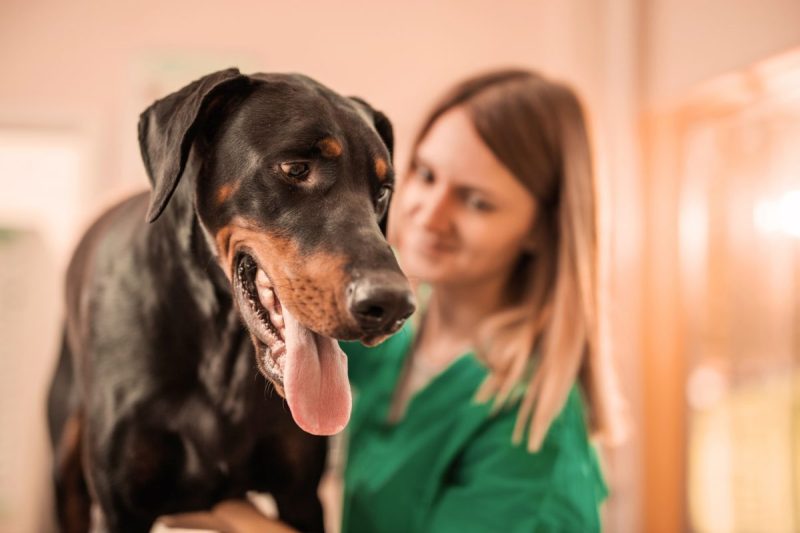Stud tail in dogs is a skin condition that affects the sebaceous gland at the base of a dog’s tail. Also referred to as supracaudal gland hyperplasia or tail gland hyperplasia, it is similar to acne in humans and is caused by the overproduction of sebum — an oily substance meant to protect and moisturize the skin. While not life-threatening, the condition can cause discomfort and lead to greasy skin, hair loss, and infection if left untreated. It is important to note that stud tail is not exclusive to dogs; it can also occur in male cats, particularly those who have not been neutered.
Here’s what you should know about the symptoms, causes, and treatments for the condition.
Symptoms of stud tail in dogs
The most noticeable symptom of stud tail in dogs is a greasy, smelly patch at the top of the tail, near the base. You might also observe:
- Loss of hair in the affected area
- Crusting or scaling
- Red, inflamed skin
- Blackheads or pimples
- Possible secondary infections marked by pus or scabbing
In some cases, the condition might cause your dog noticeable distress, leading them to lick or chew at their tail excessively.
To accurately determine if your dog is suffering from tail gland hyperplasia, your veterinarian will first examine the affected area. They may ask you about your dog’s history, grooming habits, and any other symptoms you’ve noticed. Diagnosis often involves ruling out other skin conditions that could cause similar signs, such as infections, allergies, or parasites. Your vet might also take samples from the affected area to examine under a microscope or to culture. In some cases, they may also recommend a biopsy to rule out more serious conditions.
Causes of stud tail in dogs
Stud tail in dogs is primarily caused by the overactivity of sebaceous glands at the base of a dog’s tail. These glands — responsible for producing sebum — can sometimes become overstimulated. When this happens, they produce an excess amount of sebum, which can lead to inflammation, infection, and a greasy or waxy buildup on the skin, resulting in stud tail.
The exact reasons behind the overactivity of these glands are not always clear, but it is thought to be influenced by hormonal imbalances, particularly those involving testosterone. This may also explain why stud tail is more commonly observed in intact male dogs. Additionally, factors such as poor hygiene, lack of grooming, or skin conditions can exacerbate or contribute to the development of stud tail, as these conditions can lead to blocked sebaceous glands and make the area more susceptible to infection.
Despite the name “stud tail,” this condition can also affect female dogs. For this reason, most veterinarians refer to it more accurately as tail gland hyperplasia.
Treatments for stud tail in dogs
Stud tail is not contagious to humans and can go away with appropriate management. Treatment usually focuses on reducing sebum production and controlling any secondary infections. This may include:
- Improving hygiene practices: The first approach to managing stud tail involves improving the cleanliness and hygiene of the affected area. You can start by gently washing the top of your dog’s tail with a mild, dog-specific medicated shampoo recommended by your vet. This will help remove excess oils and debris that may be contributing to the condition. It’s important to rinse thoroughly to remove all soap residue, as any leftover product can irritate the skin further.
- Medications: For more severe cases, your vet may prescribe oral medications. This could include antibiotics to fight any secondary infections or corticosteroids — like prednisone — to reduce inflammation and provide relief to your dog.
- Regular grooming: Regular grooming sessions are important to prevent issues like stud tail from becoming a bigger problem. When grooming, pay special attention to the tail area. Ensure you’re brushing away any debris and checking for signs of infection or worsening symptoms. If your dog has a particularly thick or long coat, trimming the hair around the base of the tail can also help reduce oil buildup.
- Diet and supplements: Feeding your dog a balanced diet rich in omega-3 fatty acids may help improve skin health. Supplements containing fish oil, for example, can be beneficial, but it’s best to consult with your vet before adding any supplements to your dog’s routine.
If you have an intact male dog who is suffering from recurrent episodes of stud tail, you might want to discuss the option of neutering with your veterinarian. Neutering can significantly reduce the hormone levels that contribute to the overactivity of the sebaceous glands, offering a long-term solution to the problem.

